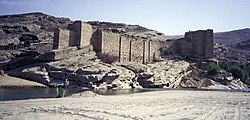Prior to 20th century
| Part of a series on the |
| History of Yemen |
|---|
- 530 CE - Abraha in power, with Sana'a as his capital (approximate date). [1]
- 570 - Siege of Sana'a (570); Sassanids in power.
- 715 - Great Mosque of Sana'a building expanded.
- 869 - Hiwali Yufirids in power (approximate date). [2]
- 901 - Town occupied by forces of Zaidi Yahya bin al-Husain. [2]
- 905 - Karmatian Ali bin al-Fadl in power. [2]
- 915 - Yufirid As'ad bin Ibrahim in power. [2]
- 956 - Town taken by Zaidi Mukhtar. [2]
- 1062 - Ali al-Sulayhi in power. [2]
- 1067 - Sulayhid capital relocated from Sana'a to Jibla by Arwa al-Sulayhi (approximate date).
- 1221 - Rasulid Badr al-Din Hasan in power. [3]
- 1259 - Earthquake. [2]
- 1538 - Ottomans in power. [4]
- 1602 - Ottomans ousted. [4]
- 1872 - Ottomans in power; [5] Sana'a becomes capital of the Yemen Vilayet.
- 1887 - Population: 25,000 (estimate). [1]
- 1891
- Uprising against Turkish rule.
- Population: 50,000 (estimate). [1]



